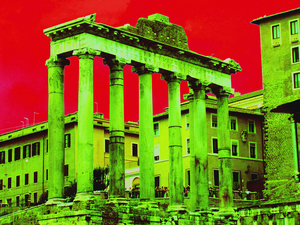As the days grow shorter and colder, something stirs in us humans—a fear that traces straight down to the bone, maybe into our DNA. We associate winter with death for good reason. It brings death for many plants, creatures and people, especially the elderly. Hippocrates wrote about seasonal mortality 2,400 years ago.
Imagine living in ancient times, before science could explain the seasons. As far back as anyone could remember, the days started getting longer again after the winter solstice. But then, for as long as anyone could remember, the gods had been appeased by sacrifices offered up during festivals. Who wanted to be first to test that correlation?
Archeological sites worldwide reveal historical obsession with the seasons, which are so intimately linked to agriculture and the ability to survive the “famine months” of winter. Nearly every culture has observed a winter solstice celebration.
In ancient Rome, Saturnalia was a seven-day festival (December 17-23) spanning the winter solstice. It honored the deity Saturn, god of agriculture and not surprisingly, associated with wealth.

Two years ago, when I visited the ancient ruins of the Roman Forum, I saw what remains of the Temple of Saturn—an eight-column facade resembling the Supreme Court building after an F4 tornado. In reading about the temple, I learned that the Romans kept their treasury of gold and silver there. (Its crumbling vestige continues to attract wealth through tourism spending.)
During the Saturnalia festival, Romans greeted each other with the phrase “Io, Saturnalia,” the equivalent of Merry Christmas. The Latin word io corresponds most closely to the English interjection yo, used like hi or hey, as in: Yo! What’s happening?
Many Saturnalia traditions inverted the normal order of things—symbolic of the celestial reversal that would bring lengthening daylight hours. Masters served slaves dinner. Courts were closed and social restrictions suspended. Overeating, drunkenness and gambling became commonplace. People exchanged gifts with poems attached, the precursors of modern greeting cards.
In AD 274, Emperor Aurelian tried to supplant Saturnalia by declaring the monotheistic cult of sol invicta (“Unconquered Sun”) a state religion, but “the sol invicta ended up looking very much like the old Saturnalia,” writes Matt Salisbury at History Today.com.
Two hundred years later, early Christians may also have hoped to tame the pagan holiday with the introduction of Christmas. Sixteen centuries have brought mixed success. Gift giving, in moderation, is a wonderful way to cement relationships, and charitable outreach this time of year reflects the best in us. But unmistakable remnants of Saturnalia live on. Excesses, like rampant materialism that drives people into debt and overindulgence in food and drink, cling to our holiday traditions (and plague our society year round, some may argue).
The dying light of approaching winter sparks that ancient urge to fatten up before the famine, to eat drink and be merry, while we can. Old habits die hard.
